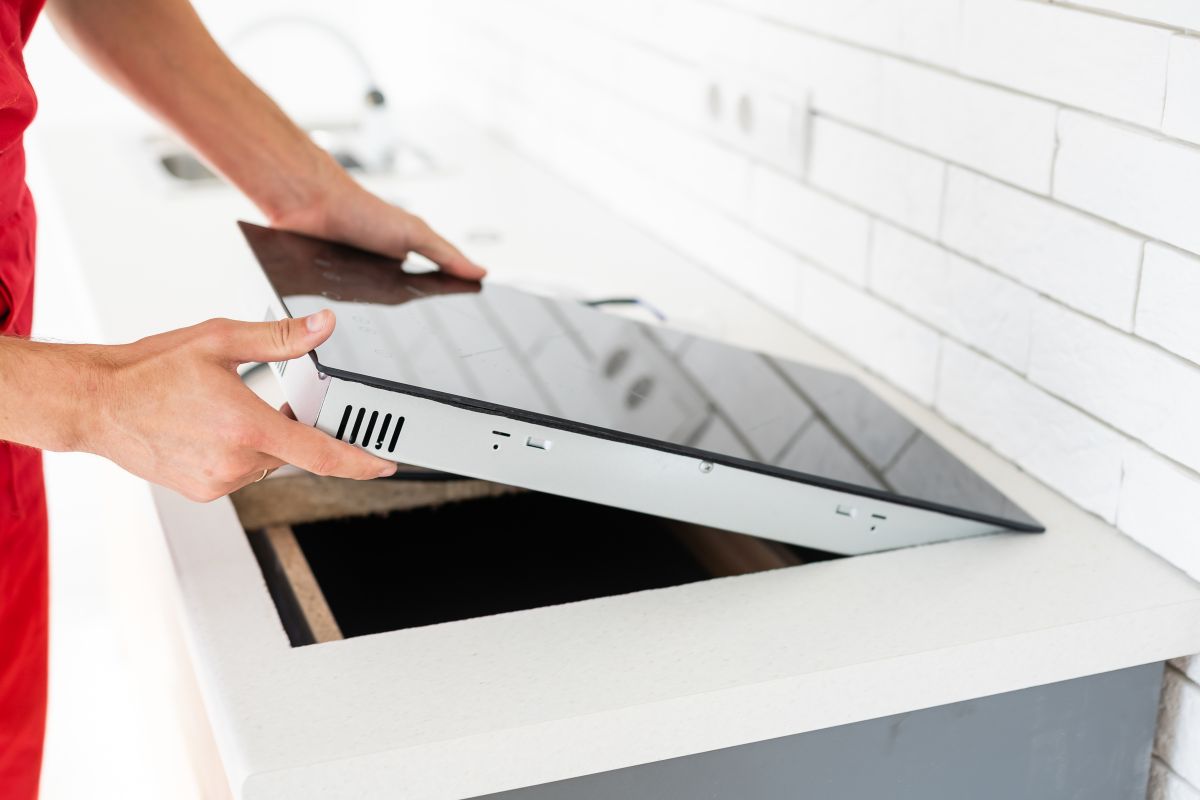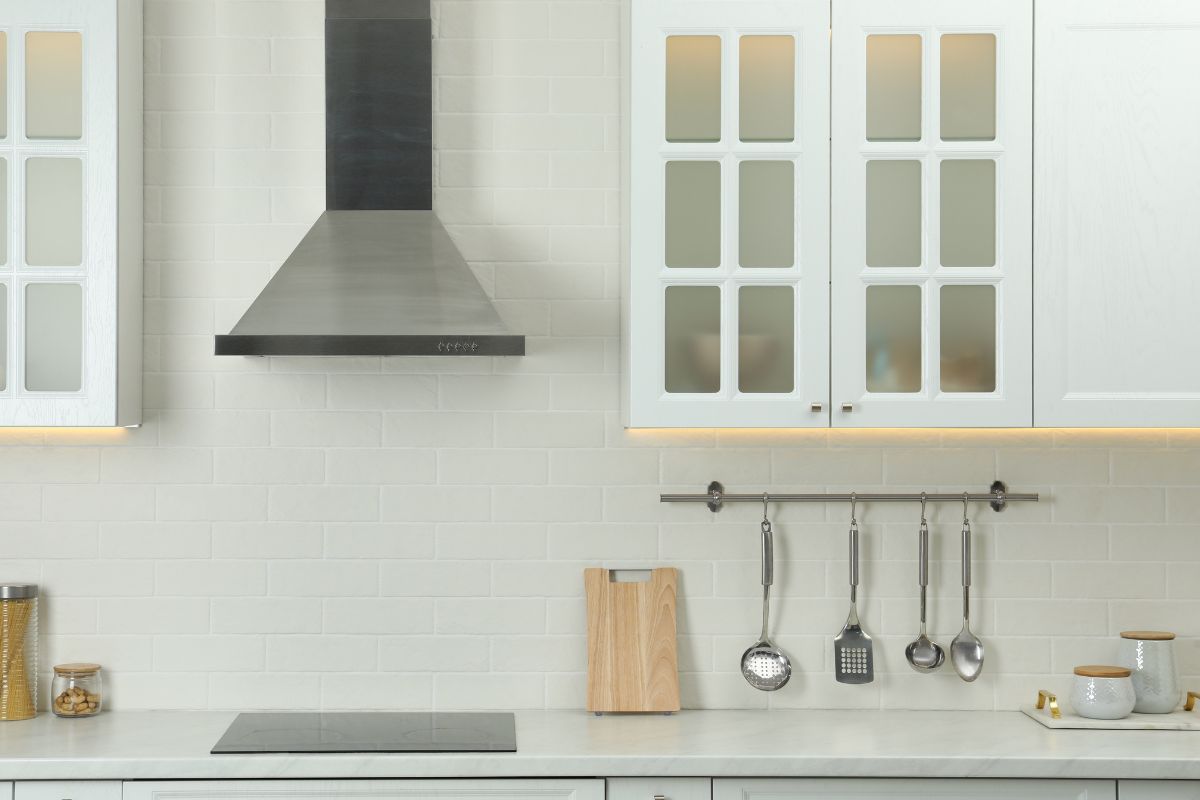You may have heard of induction cooking, but perhaps you’re not clear what exactly it is or how it works. So what is an induction cooktop? How is it different from gas or electric, and what results can you expect?

How Does An Induction Cooktop Work?
While gas and electric cooktops are self explanatory in how they heat and cook food, an induction cooktop doesn’t give much away in its name.
If you’re not familiar with this type of cooktop then it may seem a little confusing at first, but we’re here to help you understand exactly how an induction cooktop works.
Without getting too technical an induction cooktop doesn’t produce direct heat as a gas flame or an electric heating element does.
This is called thermal conduction. Instead the induction cooktop heats the cooking vessel through electrical induction.
Beneath the ceramic plate there is a coil of copper wire and when a ferromagnetic metal cooking pot is placed on top of it, an alternating current passes through it. This creates an oscillating magnetic field which generates electromagnetic energy.
The energy transfers to the cooking vessel and makes it hot enough to cook the food. The important thing to remember is that you need to use cookware that is compatible with your induction cooker.
This means it must have a magnetic base.
Features Of Induction Cooktop
An induction cooktop has a number of features that you should be aware of to make the most of this kind of cooker.
Speed
Induction cooking is very fast. As soon as you place a cooking pot on the induction cooktop the electromagnetic circuit is complete and the base of the pot starts heating up.
You don’t have to wait for a heating element to get hot in order to then heat your cooking vessel.
Induction cooktops are even quicker than gas as the flame takes time to heat the bottom of the pot and then the contents. Induction is the fastest cooking method on the market.
Responsiveness
As well as being incredibly fast, the induction cooktop is very responsive. This means that as soon as you turn the heat up or down the cooktop will respond.
While this is similar to the response you get from gas, induction tends to be more precise in its response.
Energy Efficiency
Other cooktops such as gas, solid plate and ceramic don’t just heat the cooking pot, they heat everything around them.
They also take a long time to cool down. Induction cooktops only heat the pan, nothing else, not even the surface of the cooktop. This saves on energy.
Cool Surface
One of the safety features of an induction cooktop is that it remains cool to the touch even when it is switched on. There is also no naked flame or exposed heated element which can be dangerous when there are children or elderly people in the home.
Boost Function
Another useful feature of the induction cooktop is the boost function. With this feature you can set the power level for the cooktop and then use the boost function to accelerate the power to get to that set level.
Once it reaches it, the boost function disengages.
Cookware For Induction Cooktop
If you have changed your old electric or gas cooktop for a new induction one then you may need to buy new cookware. Induction cooktops only work with ferromagnetic metals and so any cookware used will need to be compatible.
The best way to test your existing pots and pans is to use a magnet. If the magnet is pulled forcefully toward the base of the pan then it is suitable for induction use.
If there is a weak pull or none at all then you will have to buy induction compatible pans.
If you use the wrong pans on your induction cooktop, don’t worry, they won’t damage it. They simply won’t heat up and the cooktop may make a ticking sound to let you know.
What To Expect From An Induction Cooktop?
Using an induction cooktop can bring many benefits to your cooking experience. You will have improved temperature control which responds immediately to alterations. This means your food will cook much quicker than you may be used to.

It can take a while to get to grips with how differently your induction cooker works so be patient and read the instructions carefully.
An induction cooktop is much easier to clean than many others including gas and electric. Remember while the surface of the induction cooktop remains cool during cooking the hot pan will transfer heat to the cooktop surface.
Wait until it has cooled before cleaning.
Pros & Cons Of Induction Cooktop
Pros
Induction cooktops get hot very quickly and save energy as they only heat the cooking vessel and nothing else. Induction cooktops use 10% less energy than smooth top electric ranges.
The temperature control on an induction cooker is much more responsive than any other type of cooktop. When you raise or lower the temperature the effect is immediate.
The surface of the induction cooktop remains cool during cooking and only the pan heats up. However, remember that heat will transfer from the pan to the cooktop surface, so it may be hot immediately after use.
Induction cooktops are very easy to clean with spills, splatters and overflows simple to wipe clean from the smooth surface.
With no naked flame or hot electric element an induction cooktop is much safer particularly if you have children or elderly people in the home.
Cons
Oil and fat can get hot very quickly on an induction cooktop, so keep an eye on them, particularly if you are unfamiliar with using an induction stove.
Initially an induction cooktop may be expensive to buy and to fit but over time the energy you save will help you to recoup the cost.
Final Thoughts
We hope that you have enjoyed this guide to what an induction cooktop is and how it works. Happy cooking!
- How To Reheat A Cheesesteak - November 5, 2023
- What Are Three Must Have Kitchen Knives? - September 22, 2023
- How To Protect Edges Of Pie Crust - June 15, 2023








